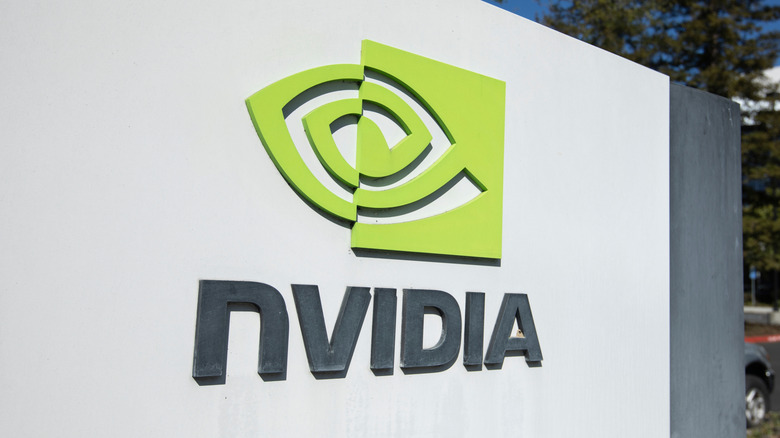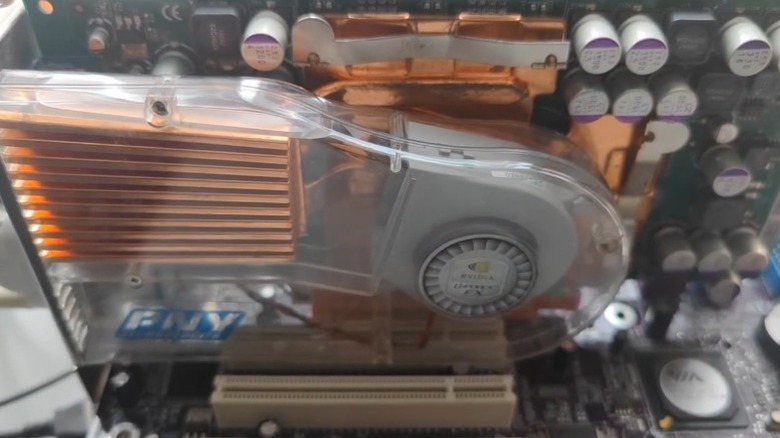This GPU Was So Loud That Nvidia Made A Funny Video About It
There are a lot of performance metrics to consider when choosing an Nvidia GPU,including CUDA core count and VRAM, as well as newer features like Ray Tracing, DLSS, and AI generative performance, but one feature that often gets overlooked is volume. Microchips generate a lot of heat, and every graphics card needs some kind of cooling system to perform to its full potential. These usually involve integrated fans, which can sometimes be quite noisy and irritating for the user. Nothing breaks the immersion in a gaming session quite like the loud buzz of overworked cooling fans struggling to keep your GPU from overheating. Plenty of cards have had this issue in the decades since the technology was invented, but one model in particular was infamously loud.
Back in 2003, the major graphics card brand Nvidia released its GeForce FX 5800 Ultra performance-grade graphics card. This GPU was built on 130 nm architecture, had 128 MB of GDDR2, and clocked in at 400 MHz. While that might seem more than a little underwhelming when compared to the 50 Series cards that Nvidia has on the market today, the FX 5800's specs were sufficient to pique the interest of gamers at the time. There was just one problem: the FX 5800's cooling fans were incredibly loud. As you probably imagine, this sparked backlash from fans as buyers complained about the noisy card, but it also led to Nvidia making one of the funniest counter-marketing videos in the company's history.
Backlash to the FX 5800's volume
Nvidia and AMD have been the two companies at the forefront of computer graphics card design for decades, but the GeForce FX 5800 was seen by many as something of a rare miss on the manufacturer's part. "You could hear it all the way from the other side of the lab, provoking lots of laughter from the staff working there at the time," said Ben Hardwidge of PCGamesN about his experience testing the card. "The solid wall of noise could be likened to a hairdryer, but it also had a high-pitch whir — combine a dentist drill with a hairdryer and you'll have an idea of how it sounded." So, clearly, that's less than ideal for any user, much less the gamers that the card was targeted towards.
Hardwidge wasn't alone in his assessment either. Anand Lal Shimpi of AnandTech did a breakdown, explaining that a major part of the problem came down to the 3D housing over the fan, which was, ironically, designed to help minimize the sound. "When the 3D pipeline is not in use, the card will operate at lower clock speeds (300 core / 600 mem to be specific). The lower clock speeds enables NVIDIA to run the very loud fan at a much slower speed and still provide adequate cooling to the GPU and its memory. As soon as there is activity in the 3D pipeline, the clock speeds increase to their 3D setting (500/1GHz) and the fan spins quicker to deal with the increased temperatures." Shimpi even shared a video showcasing the difference in volume when the card's clock speed increases, and to say that the sound is unpleasant would be an understatement.
Nvidia made a video satirizing the controversy
Rather than attempt to sweep the company's unfortunate misstep under the rug, Nvidia opted to steer into the metaphorical skid. The company released a satirical video that joked the card's noisy fan was a feature, and not a bug.
The video is titled "The Decibel Dilemma," and it frames several Nvidia marketing executives having a meeting in late 2022, just before the card was released. These executives argue that the card was so powerful that it could be compared to auto brands like Porsche, Ferrari, and Harley-Davidson. "When people buy a Harley or buy a Porsche, one of the main things they're looking for is that distinct noise that it makes," said Vice President of Marketing, Dan Vivoli. "It's a unique sound. It's soothing!" The video is interspersed with several hard cuts over the course of this conversation to some of the other machines that the FX 5800 has been compared to: A dentist's drill, hair dryer, coffee grinder, leaf blower and other machines that make obnoxiously high-pitched whirring noises. This juxtaposition highlights the absurdity of the idea that fans would enjoy such a loud computer component.
The video ends with Production Line Manager Geoff Ballew questioning whether the card might actually be a bit too noisy for some people, to which the entire group replies, "Nah!" While some may have seen the attitude of this video as cavalier towards those loyal fans who were disappointed in their purchase, others found the video to be a humorous and refreshingly candid acknowledgement of error from the company.

